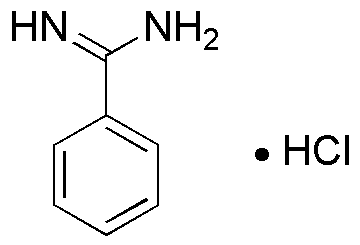Benzamidine hydrochloride, anhydrous is widely utilized in research focused on:
- Biochemical Research: It serves as a potent inhibitor of serine proteases, making it valuable for studies on enzyme mechanisms and protein interactions.
- Pharmaceutical Development: This compound is used in the formulation of drugs targeting various diseases, particularly those involving coagulation and inflammation.
- Diagnostic Applications: It is employed in assays to detect and quantify protease activity, aiding in the diagnosis of certain medical conditions.
- Antiviral Research: Benzamidine hydrochloride has shown potential in studies aimed at inhibiting viral replication, contributing to the development of antiviral therapies.
- Laboratory Reagents: It is commonly used as a reagent in chemical synthesis and analytical chemistry, facilitating various experimental procedures.
General Information
Properties
Safety and Regulations
Applications
Benzamidine hydrochloride, anhydrous is widely utilized in research focused on:
- Biochemical Research: It serves as a potent inhibitor of serine proteases, making it valuable for studies on enzyme mechanisms and protein interactions.
- Pharmaceutical Development: This compound is used in the formulation of drugs targeting various diseases, particularly those involving coagulation and inflammation.
- Diagnostic Applications: It is employed in assays to detect and quantify protease activity, aiding in the diagnosis of certain medical conditions.
- Antiviral Research: Benzamidine hydrochloride has shown potential in studies aimed at inhibiting viral replication, contributing to the development of antiviral therapies.
- Laboratory Reagents: It is commonly used as a reagent in chemical synthesis and analytical chemistry, facilitating various experimental procedures.
Documents
Safety Data Sheets (SDS)
The SDS provides comprehensive safety information on handling, storage, and disposal of the product.
Product Specification (PS)
The PS provides a comprehensive breakdown of the product’s properties, including chemical composition, physical state, purity, and storage requirements. It also details acceptable quality ranges and the product's intended applications.
Certificates of Analysis (COA)
Search for Certificates of Analysis (COA) by entering the products Lot Number. Lot and Batch Numbers can be found on a product’s label following the words ‘Lot’ or ‘Batch’.
*Catalog Number
*Lot Number
Certificates Of Origin (COO)
This COO confirms the country where the product was manufactured, and also details the materials and components used in it and whether it is derived from natural, synthetic, or other specific sources. This certificate may be required for customs, trade, and regulatory compliance.
*Catalog Number
*Lot Number
Safety Data Sheets (SDS)
The SDS provides comprehensive safety information on handling, storage, and disposal of the product.
DownloadProduct Specification (PS)
The PS provides a comprehensive breakdown of the product’s properties, including chemical composition, physical state, purity, and storage requirements. It also details acceptable quality ranges and the product's intended applications.
DownloadCertificates of Analysis (COA)
Search for Certificates of Analysis (COA) by entering the products Lot Number. Lot and Batch Numbers can be found on a product’s label following the words ‘Lot’ or ‘Batch’.
*Catalog Number
*Lot Number
Certificates Of Origin (COO)
This COO confirms the country where the product was manufactured, and also details the materials and components used in it and whether it is derived from natural, synthetic, or other specific sources. This certificate may be required for customs, trade, and regulatory compliance.


